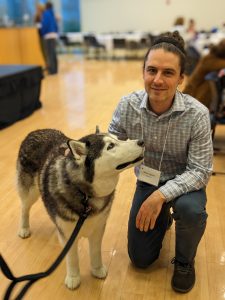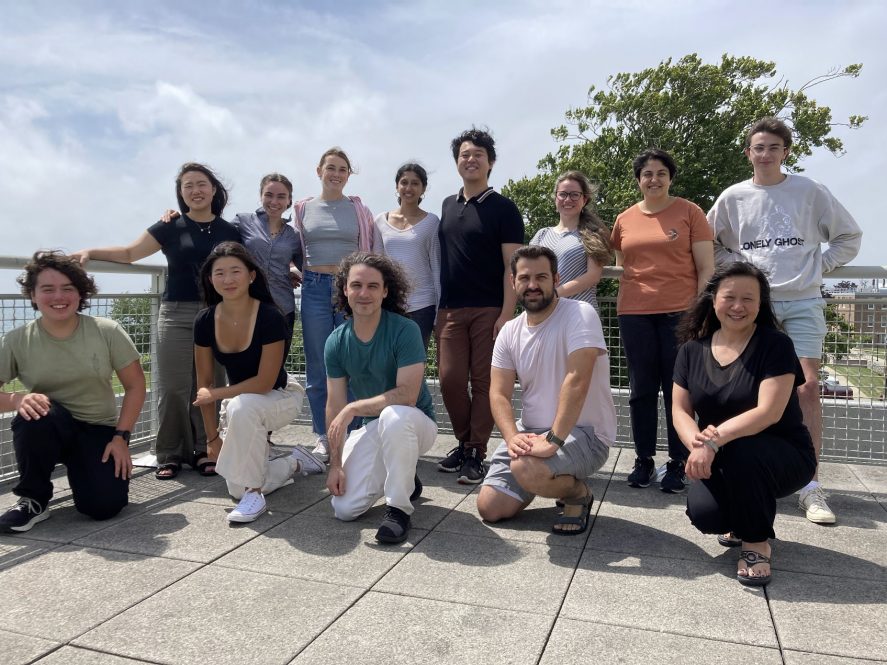Looking at the research published by Derek Aguiar and his lab over the past few years – ranging from drug side effect prediction to modeling genetic variation to predicting the outcomes of motions submitted in legal trial proceedings – one might conclude he’s a jack of all trades.

Actually, he’s a master of one: computer science (CS).
Aguiar is an associate professor in the College of Engineering who believes there’s no limit to the potential applications of CS. He follows his own curiosity, which frequently lands him in interdisciplinary projects involving other schools and colleges at UConn or multi-institutional collaboratives. And he encourages his students to do the same.
“I’ve ‘adopted’ some students that specialized in other areas,” he jokes, by way of explaining the astonishing diversity of his lab’s research subject matter.
For his own part, Aguiar is chiefly interested in blending graph-theoretic algorithms with probabilistic machine learning approaches. These are the CS techniques he studied in his Ph.D. at Brown University and his postdoctoral scholarship at Princeton University. Combining them, he has developed new applications for genomics and genetic data to help understand complex disease.
Launching the Next Generation of Computer Scientists
As a first-generation undergraduate at the University of Rhode Island, Aguiar didn’t yet realize that he wanted to pursue a career in research, or that such a thing was even possible. He graduated without lab experience (“This isn’t a good template for other people to follow,” he notes).
But then, while pursuing graduate studies at Brown, he realized how “beautifully” his life-long interest in CS could combine with biology.
“I really saw the mathematical, statistical, and algorithmic beauty in biology,” he says. “It has a long history – some very important and deep results [in biology] have come from statistics and computer science. That’s where I fell in love and became enamored with the blending of CS and biology.”
Now, Aguiar is dedicated to pursuing original research and mentoring students in CS. He doesn’t want any would-be computer scientists to miss the chance to conduct research in college, like he did – in fact, he’s helping them get a head start, by mentoring high schoolers from across the region.
Most of Aguiar’s high school mentees are from Glastonbury, where students are paired with researchers through the Advanced Research Mentorship program. A few enterprising students from other schools have also sought him out for mentorship as well. He recently worked virtually with a protege from Massachusetts who went on to enroll at UConn.
“They come to UConn for about two hours after their high school gets out, once a week,” Aguiar says, “and we work on CS and research projects together. Eventually, they present their research internally at their high schools, and some go on to present at the CT Science and Engineering Fair.”
Aguiar was also a co-organizer of the New England Computer Science Teachers Association New England conference, which was held at UConn Storrs for the first time last year.
From DNA to Honest Abe
Most recently, Aguiar’s work has been supported by an NSF CAREER award; a four-year, nearly $200,000 award from the National Institutes of Health (NIH); and an award from the Horace Bushnell Memorial Hall Corporation, the foundation that operates the Bushnell Performing Arts Center in Hartford.
The first two awards support Aguiar’s work on genomics projects. The CAREER award will allow him to continue his work in modeling haplotypes: sets of DNA variants co-inherited along a single chromosome. Aguiar develops algorithms to help understand how these haplotypes are inherited and how they relate to complex diseases.
With the NIH funding, Aguiar is developing novel computational immunology programs to help determine the risk of cardiovascular disease among people with type 2 diabetes. One of the ultimate aims of this research is to enable further investigation into the casual relationship between type 2 diabetes and heart disease, a puzzle scientists have been trying to solve since the correlation was first identified.
With the Bushnell group, the research looks a bit different. Aguiar is working on a project that seeks to infuse a little theater and CS magic into middle school history lessons: he’s developing an AI version of Abraham Lincoln, using a large language model fed on Lincoln’s extensive body of written work and verbal addresses.
“The idea behind this project is to rethink how middle schoolers learn,” Aguiar says.
Instead of just reading or watching a documentary about Lincoln, this project will allow students to actually have a conversation with him, learning about his viewpoints and gaining a better understanding of his historical milieu. It seeks to fill a gap in middle-grade learning that Aguiar identifies as critical.
“Middle school students don’t really skip school – they’re always there – they’re just not very engaged,” he explains. “We’re trying to increase engagement by providing an experience in the social sciences where you don’t just read a book or listen to your teacher and then regurgitate facts. We’re trying to turn this into an experiential process where instruction is personalized for each student.”
What’s Next?
Aguiar is currently collaborating with Rachel O’Neill, director of UConn’s Institute for Systems Genomics, on a project that will help identify irregular DNA formations that have been linked to increased mutation rates and cancer.
“DNA can actually fold into different structures, other than what’s known as B DNA – the canonical double helix structure,” he explains.
One of the major ways geneticists sequence DNA is through nanopore sequencing. In this process, an enzyme unzips DNA into single strands, which are then pushed through a microscopic sequencing device.
Aguiar and O’Neill discovered that these irregular DNA formations can impact the time it takes DNA to move through the process, since it takes longer for enzymes to disentangle these structures.
“We discovered that the genomic locations where these structures can form are associated with differential nanopore translocation times,” Aguiar says. “That hadn’t been done before.”
As he continues his career at UConn, Aguiar anticipates embarking on more exciting research across all domains. He’ll also work to keep enacting his other central focus – supporting students, on whatever paths they choose to pursue.
“It’s super important that my students are well-rounded researchers, which includes being good communicators and educators,” he says. “But it’s not important for my students to follow in my footsteps – I want them all to do whatever makes them happy, and hopefully they are using what they learned in the process of earning their degrees!”



